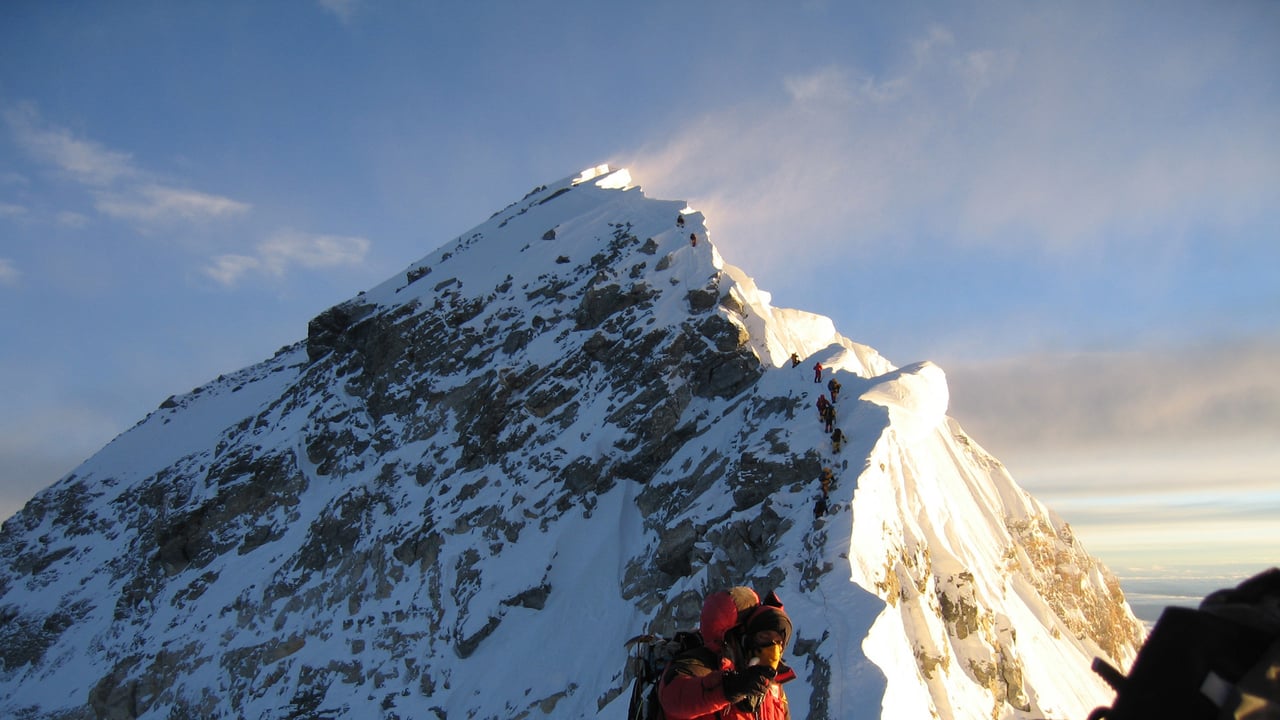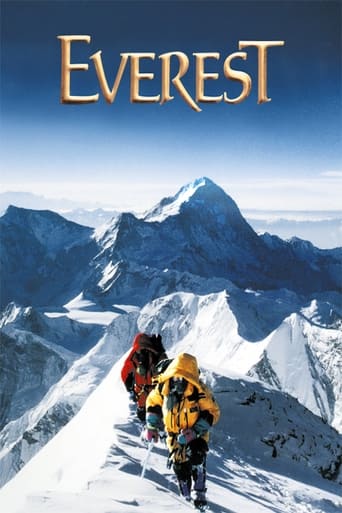

Save your money for something good and enjoyable
... View MoreCrappy film
... View MoreAn absolute waste of money
... View Morean ambitious but ultimately ineffective debut endeavor.
... View MoreIt seems that producers believe audience interest would lag if a film about Mt. Everest focused primarily on climbing technique and mountain scenery. Perhaps they are correct. In any case, the IMAX production, "Everest," joins a group of similar offerings in seeking to retain the audience's attention by making human interest stories its central focus. Some viewers may be pleased to see a personal element injected into the presentation. But the effect can be to convert a mountain adventure into a Himalayan soap opera. In "Everest," we follow Jamling Tenzing Norgay as he seeks to emulate his father Tenzing Norgay (who, together with Edmund Hillary, was the first person to reach the summit); Ed Viesturs, a world-class climber who is spending his honeymoon on the mountain; and Araceli Segarra, who is attempting to be the first Spanish woman to reach the summit. It is interesting to learn about them, but the process of meeting them and following them to Katmandu consumes roughly one-fourth of "Everest"—rather too much in view of the fact that its duration is only about 42 minutes.There are some good shots of the IMAX expedition's trek up to the base camp. Then "Everest" follows the climbers through the ice fall to their middle camp. The jewel case informs readers that "Everest" was "Filmed During The Infamous 1996 Climbing Disaster Documented in Into Thin Air." To some this might suggest that the film is about the 1996 disaster. But, when planning their expedition, the IMAX producers did not know there would be a disaster. They wanted to document a climb to the summit, and just happened to be on the mountain when the disaster occurred. The film does offer a six-minute interlude about the disaster; and this is appropriate, because some members of the IMAX expedition participated in the rescue efforts. But there is no original footage of the storm, during which visibility was virtually nil. The film's final eleven minutes take viewers to the top of the mountain. There are some spectacular views of the mountain and its surroundings; but these do not adequately exploit the wide-angle panoramic potential that is the special strength of IMAX photography. In a decision symptomatic of the film's unfortunate priorities, on breathtaking views from the summit, the producers chose to superimpose snapshots of the climbers panoplied in climbing suits that concealed both their identities and their emotions.In a sense, the extras are better than the feature. This is especially true of "The Making of Everest," a 37-minute segment that explains how the movie was made. In this, we learn about the logistical implications of IMAX photography. A frame of film exposed by an IMAX camera is ten times as large as that exposed by a traditional 35mm film camera. IMAX cameras consume film at the astronomical rate of 360 feet per minute—a 500-foot reel yields only 90 seconds of film. Since the customary 100-pound IMAX camera was unsuitable for "Everest," engineers designed a compact 40-pound version specially constructed to withstand the cold. Four sherpas had the task of getting the camera gear up the mountain—separately assigned to carry the camera, the tripod, the film, and the batteries and other accessories. In order to film, the camera crew had to prepare special landings for the tripod, set up all the equipment, and load the film. Only tremendous effort and favorable weather enabled the IMAX expedition to succeed in their venture. But this was not "Candid Camera"—with this technology, there could be no close-up pictures of a climber ascending the Hillary Step."Everest" provides five minutes of footage that was omitted from the main feature. This is presented with music, but without commentary. Given the costs and technical requirements of IMAX photography, all the filming was carefully planned. And some omitted shots are so good one wonders why they were not used. There are also the Climbers' Video Journals, in which Segarra, Norgay, and Viesturs discuss their climbing experiences. Without doubt, the most gripping of the extras are the 36 minutes of outtakes from what must have been a lengthy interview of Beck Weathers, the Texas physician who lost both of his hands to frostbite during the 1996 storm. Weathers describes his reasons for climbing and its dangers; and offers his perspective on 1996, especially on his own nearly miraculous survival.This is a good film; but it would have been improved with more panoramic shots.
... View MoreI'm sorry but this movie is awful! I can't decide whether is a movie or a documentary, the story it's horrible, you don't get to know the characters so you don't feel sorry for any of them. Liam Neeson just narrates some parts, but it's like nothing. The only think I liked was that you can see the mountain pretty good but that's ALL. Besides, the story is too short and you can't get attached to anything. You can bearly see the actors faces and the music just doesn't do it. I mean...they put music for movies like..Superman! It's incredible how bad is this movie, when I saw it, I just couldn't believe it.Sorry folks, but it's horrible. Don't see it. Trust me.
... View MoreSadly, a film replete with missed opportunities. Many of the other reviewers have nailed it. There are one or two excellent scenes, but the film is basically a New Age take on the expedition...we are supposed to get tuned into the spiritual side of the effort, understanding inner need and dedication. We are supposed to feel one with the mountain and the world.Screw that! This film is a complete failure at helping the viewer appreciate the complexity and adversity involved in the effort. I have to marvel at how this film actually makes the ascent look fairly effortless. The recreations are also a waste of the viewer's time.Not recommended unless the only time you get to see it is in an IMAX theater...and then it still runs a distant second to going a couple hundred miles and seeing some snow yourself. This film is an insult to the mountain climbing community. Or maybe it's an inside joke.This is a 2 on a scale of 10.
... View MoreSome of the camera work in this IMAX feature is absolutely stunning. And the mere fact that the crew was able to lug a bulky, heavy IMAX camera and film to the summit of Everest is a testament to sheer guts and determination. Unfortunately, the end result is somewhat of a mixed bag. There are moments of great emotional intensity (most notably, the miraculous Beck Weathers rescue), but, like a few others here, I got the feeling that much of the potential of the IMAX format simply went to waste. IMAX is, after all, an overwhelmingly visual medium, so why waste so much time on trying to create a Hollywood style `story' out of it? I mean, if I had gone to all the effort of getting that camera to the top, I'd have damned well given the audience some spectacular panoramic shots of the view from the summit instead of wasting valuable footage on two climbers hugging each other (a scene that would have worked just fine if shot on plain old videotape). In summation, this film has some truly amazing moments, but as a whole, it seems the creators failed to use the IMAX format to the maximum potential. PS: The DVD version contains lots of good supplementary material, in fact, the `making of the film'
... View More